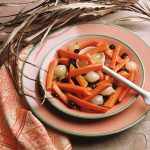(HealthDay News) — Obesity can develop as a result of poor eating habits, inactivity or genetics. To help prevent obesity, the URMC suggests: Work to change your family’s eating habits and activity levels. Be a role model for healthy eating and physical activity. Limit screen time to less than two hours per day. Keep the pantry stocked with healthier snacks.
A little about: Weekly Gravy
All Sauce from Weekly Gravy:
What Are the Most Dangerous Food Groups?

Fruits, vegetables, whole grains, nuts and seeds — we hear a lot about the “best” food groups for health. But what about the worst ones? What foods should you be eliminating or at least cutting back on? Research published recently in the Journal of the American Medical Association looked at dietary intake and 318,000 deaths from diabetes, stroke and heart disease. In addition to not eating enough omega-3 rich seafood, nuts and seeds, two problematic factors stood out. These deaths were associated with eating too much salt and too many processed meats. The two go hand-in-hand in sausages, hot dogs, corned beef, beef jerky, canned meat, meat sauces, lunch meats and bacon. Eating too much salty food was associated with nearly 10% of those deaths. Processed meats are a key source of salt, but so are snacks, prepared foods and even packaged vegetables, especially those canned in salt. A separate study of 400,000 deaths related to heart and blood vessel diseases presented at an American Heart Association scientific meeting came to similar conclusions — finding 9% of these deaths were due to too much salt. The very unhealthy trans fats were also on the dangerous foods list. Fortunately, these are being phased out of packaged foods. But again, what you’re not eating makes a difference, too. These researchers also found that not getting enough whole… read on >
How to Move Past Life’s Inevitable Speed Bumps

Setbacks are a part of life for everyone, but these stumbling blocks can be extremely difficult, even debilitating, to navigate. Taking certain steps can make it easier for you to rebound, according to experts at the University of California, Berkeley’s Greater Good Science Center. It’s easy to get caught up going over what happened again and again in your mind. But instead of simply reliving the event, spend the time exploring your feelings surrounding it. Putting them down on paper can give you insights into the situation, help you learn from the experience and finally move forward. Rather than berate yourself for whatever role you played in what happened, show yourself the same compassion you show friends and loved ones when you see them struggling with a serious issue. Be kind to yourself — this can change your mindset from blame to being open to finding better solutions in the future. If the situation was brought on by the actions of another person (or more than one), forgiveness may help you move forward. That doesn’t necessarily mean you must reconcile with the offenders — it’s possible that their actions are inexcusable and you can’t go back to the relationship you had before. But forgiving them will stop you from wasting your valuable energy on holding a grudge and, again, allow you to go forward and… read on >
Even Slightly Elevated Blood Pressure Early in Pregnancy a Bad Sign

Even a small increase in blood pressure during your first trimester could spell bigger trouble later in your pregnancy, new research suggests. Those troubles can include gestational high blood pressure, which develops after the 20th week of pregnancy, and preeclampsia (high blood pressure and protein in the urine), the researchers explained. Both conditions increase the risk for stroke in an expectant mother and for stillbirth, preterm birth and low birth weight. Preeclampsia also increases the risk of life-threatening seizures in the mother (eclampsia). In this study, the researchers analyzed data from about 8,900 pregnant women in the United States. Of those who had elevated blood pressure in the first trimester (120/80 to 129/80 mm Hg), just over 30% developed a high blood pressure disorder of pregnancy. This was a 42% higher risk than among women with normal blood pressure (less than 120/80 mm Hg) in the first trimester. Among women with stage 1 high blood pressure (130/80 to 139/89 mm Hg) in the first trimester, almost 38% developed a hypertensive disorder of pregnancy, which was an 80% higher risk than among those with normal blood pressure, the findings showed. Stage 1 high blood pressure was associated with more than 2.5 times the risk for preeclampsia, according to the study. An increase in blood pressure between the first and second trimester also increased the risk of… read on >
Forget the Past: Get Moving Now and Live Longer

Stop agonizing over the decades you spent glued to the couch. New research shows that physically active middle-aged and older adults live longer — even if they were inactive when they were younger. And that’s even if they had previous serious health problems, according to the British study. “These results are encouraging, not least for middle-aged and older adults with existing cardiovascular disease and cancer, who can still gain substantial longevity benefits by becoming more active,” said Soren Brage, of the epidemiology unit at the University of Cambridge, and his colleagues. The study included nearly 14,600 men and women, ages 40-79, who were recruited between 1993 and 1997. They underwent four assessments up to 2004. Deaths were recorded up to 2016. During follow-up, there were more than 3,100 deaths among the participants, including about 1,000 each from heart disease and from cancer. The researchers controlled for risk factors such as diet, weight, medical history, blood pressure and cholesterol levels. They concluded that higher physical activity levels and increases in physical activity over time were associated with a lower risk of death. What counted as physical activity? The research noted activity at work, sports and recreational exercise. Among those who were inactive at the start of the study and gradually met minimum physical activity guidelines over five years, there was a 24% lower risk of death… read on >
Alzheimer’s Genes Might Show Effects in Your 20s

Every college student misplaces keys or forgets an appointment from time to time. Usually it’s no big deal. But a new study warns that when young people with a family history of Alzheimer’s disease have memory lapses, it could be an early sign of something serious. That’s the concern raised by a new memory test taken by nearly 60,000 men and women between the ages of 18 and 85. The results revealed that participants between 18 and 65 who had family members with Alzheimer’s scored lower than those who did not. That included even young adults in their 20s. But, “no one should feel doomed to experience Alzheimer’s, certainly not simply because your parents or grandparents were diagnosed with the disease,” stressed study author Matt Huentelman. He is a professor of neurogenomics with TGen, a genetics research institute based in Phoenix. Lots of non-inherited factors play a role in Alzheimer’s risk, he explained. And, “there are many cases of people with family history and/or high genetic risk for Alzheimer’s who live long lives without memory problems.” But there’s no getting around the fact that roughly 75% of Alzheimer’s risk is thought to be driven by genetics, said Huentelman. And the test does suggest that a young person’s memory may be impacted by genetic risk “as many as four decades before the typical onset of Alzheimer’s… read on >
Health Tip: Preventing Stress Fractures
(HealthDay News) — Stress fractures are overuse injuries and usually occur in the lower leg. Typically, they are triggered by increasing the amount or intensity of an activity too quickly, says the American Academy of Orthopedic Surgeons. To prevent stress fractures, the AAOS suggests: Set incremental goals for sports and activities. Cross-train, rather than repeat the same exercise daily. Maintain a healthy diet, including vitamin D and calcium. Stop and rest if pain or swelling occurs.
Health Tip: Sun Protection for Skin of Color
(HealthDay News) — Sun protection should not be limited to those with fair skin, says the Skin of Color Society. People with darker skin are still at risk of skin cancer triggered by the sun’s ultraviolet rays. The Skin of Color Society recommends using sunscreen with an SPF of 15 or higher that protects against UVA and UVB rays. Before starting outdoor activities, people with darker skin are encouraged to check the area’s UV index and plan accordingly.
A Tasty Way to Enjoy More Carrots

Carrot sticks are fine for a snack, but that’s far from the only way to get these tasty veggies into your diet. Carrots are naturally high in beta carotene, and they’re great for liver and skin health. These sweet root vegetables come in a wide range of colors, all of which are nutritious. When buying carrots, choose those that are firm and without cracks. Store them in the fridge for up to two weeks. Note: Baby carrots are no different than regular carrots except that they’ve been cut down to a small size, at a cost to consumers. Because carrots add great crunch to dishes, you can use them raw in many types of vegetable-based salads. They’re also a great addition to salad dressings, like this one reminiscent of the kind served in Asian restaurants. Try it over a simple salad as suggested or over steamed green beans or almost any vegetable to give it more zing. Best of all, it requires zero cooking. Baby Greens With Carrot Ginger Dressing 1 pound mixed baby greens 1 pint cherry tomatoes, quartered 1 large cucumber, thinly sliced 1 large carrot, peeled and coarsely chopped 2 tablespoons sesame oil 1 tablespoon rice wine vinegar or apple cider vinegar 2 tablespoons ginger, peeled and chopped 2 garlic cloves, peeled 1/4 cup water, more as needed Arrange the greens, tomatoes… read on >
What’s The Most Effective Way to Tone Your Biceps?

The biceps, the very visible muscles in the front of the upper arms, are a target in every comprehensive strength-training regimen, but what exercise is the most effective? To answer that question, the American Council on Exercise asked scientists from the University of Wisconsin-La Crosse to evaluate eight popular biceps exercises. Popular Biceps Strength-Training Exercises Barbell curl Cable curl Chin-up Concentration curl EZ curl with wide grip EZ curl with narrow grip Incline curl Preacher curl At the very top of the list for effectiveness is the concentration curl, because it best isolates the biceps. Most of the other popular exercises also target other muscles, such as those in the shoulder called deltoids. But because the upper arm is pressed against the leg in concentration curls, the biceps is engaged the most. To do this curl, sit on a flat bench with a dumbbell in front of you. Legs are apart, knees bent and feet flat on the floor. For the starting position, hold the weight in your right arm, arm extended toward the floor, palm up. Press the back of the upper arm against the top of your inner right thigh. Now, with control, use only your forearm to curl the weight toward your biceps as you contract that muscle. Bring the weight up to shoulder level, leading with the outside of your hand… read on >









